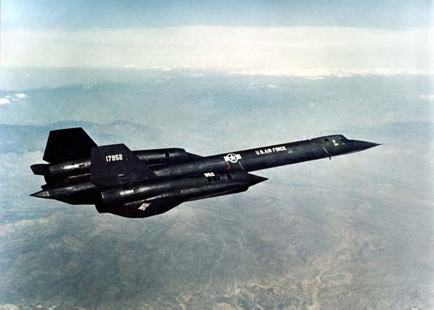
 |
Ship 952 was designated the systems and sensors test aircraft and spent its entire service life engaged in developmental flight test activities while assigned to the SR-71/F-12 Test Force at Edwards Air Force Base. It carried cameras, radar and electronic intelligence (ELINT) systems for initial (Category I) flight-testing and performance evaluation. Later, electronic countermeasures (threat warning and jamming systems) were installed.
It was also the first SR-71 used for inflight refueling tests, beginning on 29 April 1965 when it rendezvoused with KC-135A (58-0064).
In November 1965, Col. Robert L. "Silver Fox" Stephens and Maj. Kenneth D. Hurley departed Edwards in 952 for a test flight along what was known as the Northern Route. After takeoff they accelerated along the eastern side of the Sierra Nevada Mountains and, about 25 minutes later, began a slow turn to the west in the vicinity of Klamath Falls, Oregon. At this time, the airplane was traveling at Mach 3.1 and an altitude of 80,000 feet. About midway through the turn, while in a 40-degree bank, the left inlet (now lower than the right) suddenly unstarted. With a loud bang the SR-71 shuddered and began an uncontrolled left roll.
Stephens struggled to get the airplane under control while Hurley furiously scribbled notes on the situation for later use in determining a cause. Hurley paused momentarily to glance out the window and found himself looking straight down at Crater Lake. He was certain they would have to eject.
As the bank angle approached and passed 98 degrees Stephens applied full elevon and rudder control at the same time, something the engineers advised against at Mach 3 cruise conditions for fear the airframe would disintegrate. Gradually the roll rate slowed and ceased and the airplane rolled slowly to the right until its wings were again level. Had the rolling motion not stopped when it did, Stephens had been prepared to let the airplane make a complete barrel roll.
Breathing a sigh of relief, Stephens restarted the inlet and engine. He then accelerated to Mach 3 and headed south. Over the town of Bakersfield, California, he throttled back and began the descent to Edwards. Suddenly the left engine began to malfunction. Stephens set it to idle and proceeded to make an emergency landing at Edwards. It was later found that three of the six bleed-air bypass tubes on the left engine had split open, allowing 1200 degree F air to blast the inside of the titanium nacelle structure. Fortunately, no catastrophic failure resulted.
The airplane was repaired and returned to the Test Force. It made a total of 41 flights and logged a 79.47 flight hours.
